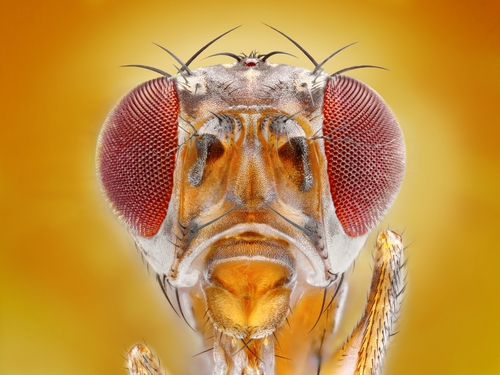
Longwood University’s Modern Genetics biology course is more than just lectures and labs. It’s a research-focused experience for students—some of whom contributed to a published peer-reviewed scientific paper—in a nationwide genomics research project.
Students in the course work with raw DNA sequencing data from fruit flies, commonly used in genomics, to extract new information by finishing the sequencing and annotating genes. The course evolved from Longwood’s participation in the Genomics Education Partnership (GEP), a collaboration between about 130 institutions and the biology department and Genome Institute at Washington University in St. Louis.
"The idea behind this approach is to put research in the classroom," said Dr. Consuelo Alvarez, professor of biology. "It gives students experience in bioinformatics, which is analyzing data from biology experiments. The main research question is: Why are some genes expressed in some species of fruit flies but not in others?"
The GEP provides the data, which undergraduates around the country work on in class. The results of their work are entered into a national database after being verified by graduate students at Washington University.
Longwood joined the GEP in 2007, the year after it started, at Alvarez’s instigation. She developed the Modern Genetics course and has taught it five times, most recently in spring 2015. The junior-level course was taught in 2013 by Dr. Dale Beach, assistant professor of biology. GEP projects also are flexible enough to adapt as independent studies and research, which has occurred three times with Alvarez’s mentoring.
"The students’ work in comparative DNA sequencing is contributing to our understanding of science and genomic concepts," said Beach, who, like Alvarez, is a molecular biologist. "Genomics is increasingly important in the biological sciences and especially in the medical sciences."
Genomics, part of the study of genetics, uses DNA sequencing methods to analyze the structure of genomes. A genome is the complete set of DNA within a single cell of an organism. The GEP, which is studying 12 species of fruit flies, known as Drosophila, pools student efforts to improve DNA sequence quality and to generate hand-curated gene models.
"Each Longwood student works on a single, and different, chunk of chromosome," said Beach. "They first review the DNA sequence, then try to figure out the gene structure. These are two different skill sets, but both contribute to the data as a whole. They do a lot of work in a short period."
In previous classes, students learn the chromosome and gene structure as well as the basics of some of the techniques. The Modern Genetics course reinforces that knowledge and provides an opportunity for students to apply their knowledge in an ongoing research project.
"The GEP has the tools to do DNA sequencing, and they developed an analysis pipeline and a software to go with it," said Beach. "The software is mostly online; you don’t need lots of computer power. They chop it up into small chunks so that it’s convenient for students to work on."
Alvarez and six former Longwood students are listed as co-authors of a major data paper generated by student GEP research. The paper, "Drosophila Muller F Elements Maintain a Distinct Set of Genomic Properties Over 40 Million Years of Evolution," was published in the May 2015 issue of G3: Genes, Genomes, Genetics. It focused on sequencing of a peculiar segment of the Drosophila genome called the dot chromosome. The student co-authors manually corrected errors and annotated this stretch of the genome from four species.
The Longwood student co-authors, all of whom are now Longwood alumni, are Kristen Davis ’11, Carrie Dunham ’13, Alaina Grantham ’11, Amber Hare ’13, Jennifer Kane Schottler ’08 and Zackary Scott ’09. They are among 1,014 co-authors, including 940 undergraduates from 63 colleges and universities who did research from 2007-11.
"The research in the paper found genes we didn’t expect to find," said Beach. "We want to know how the genes are being turned on and turned off, so the students are looking for the on-off switches, which are called promoters. Using the fruit fly as a model, we’re looking for parallels in human biology and how we can better understand how genes work in humans."
When the course is next offered, in spring 2017, it will include new data from Longwood genomics projects that are currently under development. "We hope that future versions of the course will allow Longwood students greater opportunity to work with ‘home grown’ projects as part of the course and as research associates themselves," said Beach.

